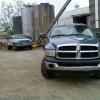Welcome To Mopar1973Man.Com LLC
We are privately owned, with access to a professional Diesel Mechanic, who can provide additional support for Dodge Ram Cummins Diesel vehicles. Many detailed information is FREE and available to read. However, in order to interact directly with our Diesel Mechanic, Michael, by phone, via zoom, or as the web-based option, Subscription Plans are offered that will enable these and other features. Go to the Subscription Page and Select a desired plan. At any time you wish to cancel the Subscription, click Subscription Page, select the 'Cancel' button, and it will be canceled. For your convenience, all subscriptions are on auto-renewal.
- Replies 47
- Views 14k
- Created
- Last Reply
Top Posters In This Topic
-
 Me78569 27 posts
Me78569 27 posts -
Vais01 7 posts
-
 organicfarmer 4 posts
organicfarmer 4 posts -
 Wild and Free 3 posts
Wild and Free 3 posts
Featured Replies
Did This Forum Post Help You?
Show the author some love by liking their post!
Welcome To Mopar1973Man.Com LLC
We are privately owned, with access to a professional Diesel Mechanic, who can provide additional support for Dodge Ram Cummins Diesel vehicles. Many detailed information is FREE and available to read. However, in order to interact directly with our Diesel Mechanic, Michael, by phone, via zoom, or as the web-based option, Subscription Plans are offered that will enable these and other features. Go to the Subscription Page and Select a desired plan. At any time you wish to cancel the Subscription, click Subscription Page, select the 'Cancel' button, and it will be canceled. For your convenience, all subscriptions are on auto-renewal.


All updates beyond this point will be placed in the article for this. You can find the article here. Feel free to post and questions or improvements to my writeup.
Thanks
Nick
Article can be found here.
Pre 7/6/15
This will show the progress in installing the he351ve into my 2nd gen cummins. I will update as I go along. This thread is not dealing with the controller needed for the he351ve. The thread that covers the controller can be found here
Parts
__________________________________________________________________________________________________
HX40 style Downpipe click to go to vulcan for the part ($125)
__________________________________________________________________________________________________
t3 to wgmt flange adapter to mate the he351ve to the t3 exhaust manifold. ($150)
__________________________________________________________________________________________________
4 Ft of 5/8' coolant hose for your local parts store ($10)
__________________________________________________________________________________________________
5/8" oil rated hose 2' worth ($5)
__________________________________________________________________________________________________
10 x 5/8" pipe clamps.
__________________________________________________________________________________________________
T3 oil drain ( ebay)
__________________________________________________________________________________________________
2 x 5/8" T fitting ($5) Local Parts Store
__________________________________________________________________________________________________
HE351Ve turbo ( $300-$600) depending on where you get it. I would suggest CumminsForum or here of course if one is for sale.
__________________________________________________________________________________________________
You will need some way of attaching the hotside intercooler tubes/boots to the turbo since the output from the Turbo faces forward rather than down like the 2nd gen turbos.
I went with the charge tube from Stainlessdiesel.com HERE
You will need a 2.75" to 3" reducer and clamps for this to work.
There are also reports that a 45* reducing elbow will work also. unsure on that but you can try.
First Specs on the Turbos
HX35 56/60/12 60ish lb/min left vs HE351ve 60/68/3-25 right 69ish lb/min
Start pulling the old turbo off
Use PB blaster or similar on the flange bolts for a few days prior to removal.
Double nut the two bottom studs and remove them so you can bolt the adapter flange to the manifold. The short bots go in the bottom and the long bolts with the nuts attach the holes of the flange.
Next if your truck is like mine (auto) there is a hard coolant line just behind the exhaust manifold that will block the rear most bolt on the adapter flange from being used. you can see the bolt hole in question.
Use the 5/8"coolant hose and a 5/8" T fitting to remove the hardline and replace it with the coolant hose. You will need to run this to just in front of the oil filter and also to the output of the coolant line from the HE351ve.
Next you need to remove the old downpipe if you don't already have an HX40 style installed. this is a PITA to say the least. I had to cut mine out. The hx40 style downpipe flange will attach to the back of the he351ve without the elbow.
In order to allow for a more vertical position of the center section I cut off the top of the strut nut.
Center Section installed and coolant hose run to the turbo. I still need to run the return to the hot line, but I need some more hose.
I used a sawzall to cut the flange off the Oil return tube. I will use some oil rated hose to connect the turbo to the return line. You can see in this picture that I just reused the OEM banjo bolts for the coolant connections. I used a hack saw to cut the braided section off so it was just a solid metal banjo bolt. I then just pushed the 5/8" coolant line over and used a hose clamp. I will do an fittings at some point, but for now this will work.
Once the center section is installed,ensure you have removed the alignment dowels from the compressor housing so you can clock the compressor like so
Use the preferred method of connecting the charge pipe, I choose the stainless diesel pipe and a 2.75" to " reducer then reused the oem 3" to 3.5" elbow at the intercooler. Alighn all boots and tighten down the clamps.
Note the position of the passenger side neg battery cable to the engine block. I might have to redo this with a new longer cable, I have been meaning to anyways, but I haven't gotten to it.
I used a pfe 5/8" hose to replace the hard metal oil drain. There is a larger diameter coupler near that block that you can insert the pfe hose into and clamp down to retain the drain connection to the block.
Hard to see in the picture but run the other coolant line into the bottom of the turbo and T into the other heater core line. Ensure you leave some space between the exhaust manifold and the coolant hose. You might use zip ties or something similar to hold the hoses together.